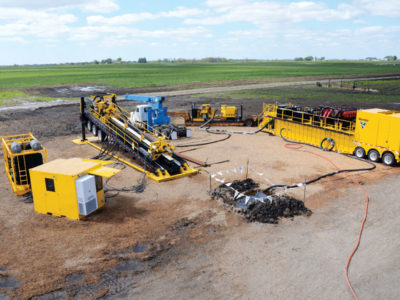Once you have your pipeline support equipment in place, it’s time to strategize about the actual drilling process. Similar to the equipment discussion, there are some extra considerations that apply to pipeline projects that don’t apply to utility jobs when it comes to drilling. We’re going to talk about three additional drilling processes you should know before launching into the pipeline industry: creating the borehole, handling the drill pipe and locating methods.
Creating the borehole
One of the obvious differences between utility and pipeline projects is the diameter of the borehole. It usually requires several reaming stages to create the final hole diameter. For example, if the final hole diameter is to be 36 inches (91.44 cm), the first ream pass might be 18 inches (45.72 cm), then maybe a 28-inch (71.12-cm) and then the 36-inch (91.44-cm) ream pass. The number of ream passes and the size of each ream pass will depend on the formation being drilled.
Handling the drill pipe
Pipeline projects are unique because large horizontal directional drills need the drill rods to be handled individually, one at a time.
“This means you’ll likely need a crane or some way to load the additional drill rods onto the drill itself,” said Marv Klein, Vermeer applications specialist.
Pipeline crews will transport the drill rods on a trailer bed and park the trailer next to the horizontal directional drill to allow for efficient loading onto the drill. When you’re drilling thousands of feet for days at a time, a lot of drill rods are required. How you handle the loading process can affect your overall productivity. Make sure you have an efficient setup for your drill and drill pipe to allow for a quick drill rod transfer.
Another factor to consider is how to handle the tooling on the exit side of the bore. This can include removing the drill head or steering tool, and adding reamers, swivels or additional pipe for trail pipe. There are different methods used to accomplish this that can be done with a range of mechanical- to hydraulic-powered equipment.
Locating methods
A third consideration is how you locate the bore. With smaller drills, most bores are located with a hand-held walkover locator device. However, this is not the case with most pipeline projects. Due to the inability to walk over the entire bore path from entry to exit, a different method of locating/tracking needs to be used to navigate the bore. A wireline steering system is the tool of choice for large pipeline crossings. This technology allows the drill operator, in conjunction with the steering hand, to navigate the bore along the planned bore path without physically walking over the bore.
“A tracking device is put in the drill head and the information is transmitted up the drill pipe via a wire that’s placed inside of each drill pipe and spliced together,” explained Klein. “The information is transferred to the steering hand’s computer, which provides the required data needed to control the progress of the bore.”
“Depending on your operation, it may make sense to invest in this technology and train someone on your team, however, the majority hire this service out to a professional company,” said Klein. “This is an extra step, but it’s one less thing you have to worry about getting trained on or learning.”
To learn more about locators, read our Pro Tips article on an HDD locator system.
These drilling differences might be new to you, but they’re key to understanding the pipeline drilling process. If you have any questions or want to learn more, contact your local dealer.
Vermeer Corporation reserves the right to make changes in engineering, design and specifications; add improvements; or discontinue manufacturing at any time without notice or obligation. Equipment shown is for illustrative purposes only and may display optional accessories or components specific to their global region. Please contact your local Vermeer dealer for more information on machine specifications.
Vermeer and the Vermeer logo are trademarks of Vermeer Manufacturing Company in the U.S. and/or other countries. © 2021 Vermeer Corporation. All Rights Reserved.
